What is Hindu (Vedic) measurement (units) of time information (facts)
Namaste friends, how are you doing today? Welcome to #BhagavanBhakthi website / blog.
Bhagavan Lord Sri Vishnu blessings to you and your family!
In this website / blog, you will always learn about #Hinduism #Sanskrit language.
Also subscribe to my YouTube channel from this link #BhagavanBhakthi to view videos about #Hinduism #Sanskrit language.
Before knowing about “What is Hindu (Vedic) measurement (units) of time information (facts)“, let us know few basic information about related Hinduism facts.
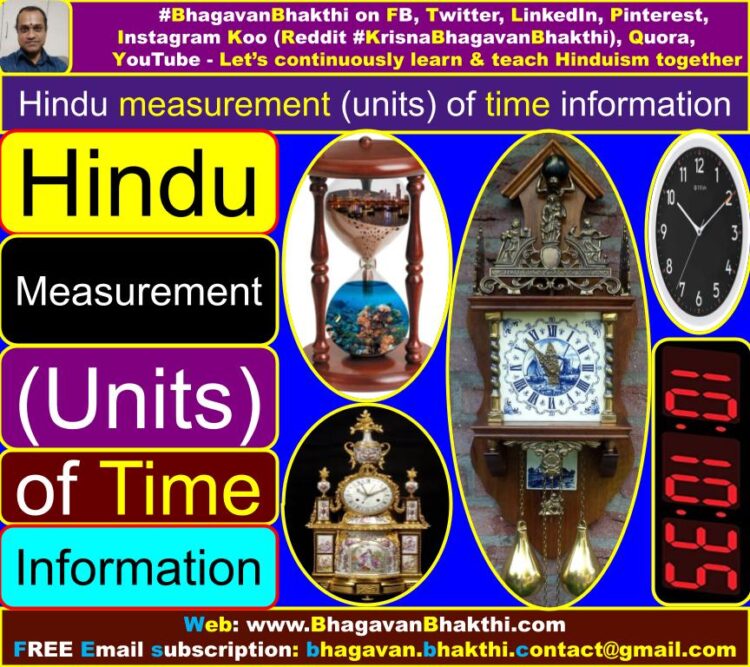
Hinduism is existing since the ‘adi kalam‘ (Grand unknown time) and will exist until the ‘ananta kalam‘ (Grand infinite time).
No one knows when the Hinduism (Sanatana Dharma) was started. Only Lord Sri Vishnu is aware of this.
Lord Sri Vishnu was the founder of Sanatana Dharma (Hinduism).
No one knows the birth day of Lord Sri Vishnu as he never took the birth and he doesn’t has the end.
Thus Lord Sri Vishnu is called as ‘Adi Deva‘ (Unknown grand first time frame) and ‘Ananta Deva‘ (Unknown grand infinite time frame).
Here ‘Adi deva‘ means, he is the one who is existing since the ‘Grand unknown period‘ and ‘Ananta Deva‘ means, he is the one who is last until the ‘Grand unknown infinite period‘.
Even Goddess Sri Maha Lakshmi Devi, Lord Sri Brahma Deva, Goddess Sri Saraswati Devi, Lord Sri Rudra Deva (Shiva),
Goddess Sri Parvati Devi, Lord Sri Indra Deva etc. are not at all aware about the existence of the Supreme Lord Sri Vishnu.

Content of this post is as given below:
Nimesha | Kalas | Muhurta (Muhurat) | Humans one month | Shukla Paksha | Krishna Paksha | Night and Day for Pitrus (ancestors) |
Thirty human months | Divaratara | Ayanas | Uttarayana | Dakshinayana | Thirty human years | Yugas | Satya Yuga | Treta Yuga |
Dwapara Yuga | Kali Yuga | Maha Yuga | Sandhyamshas | Manvantara | Kalpa | And many more…
Now, let’s move to know about the “What is Hindu (Vedic) measurement (units) of time information (facts)“:
List of Hindu measurement (units) of time information (facts) is as given below:
Nimesha : The smallest unit of time is a nimesha; this is the amount of time it takes to blink.
Fifteen nimeshas make one kaashtha and thirty kaashthas are one kaala.
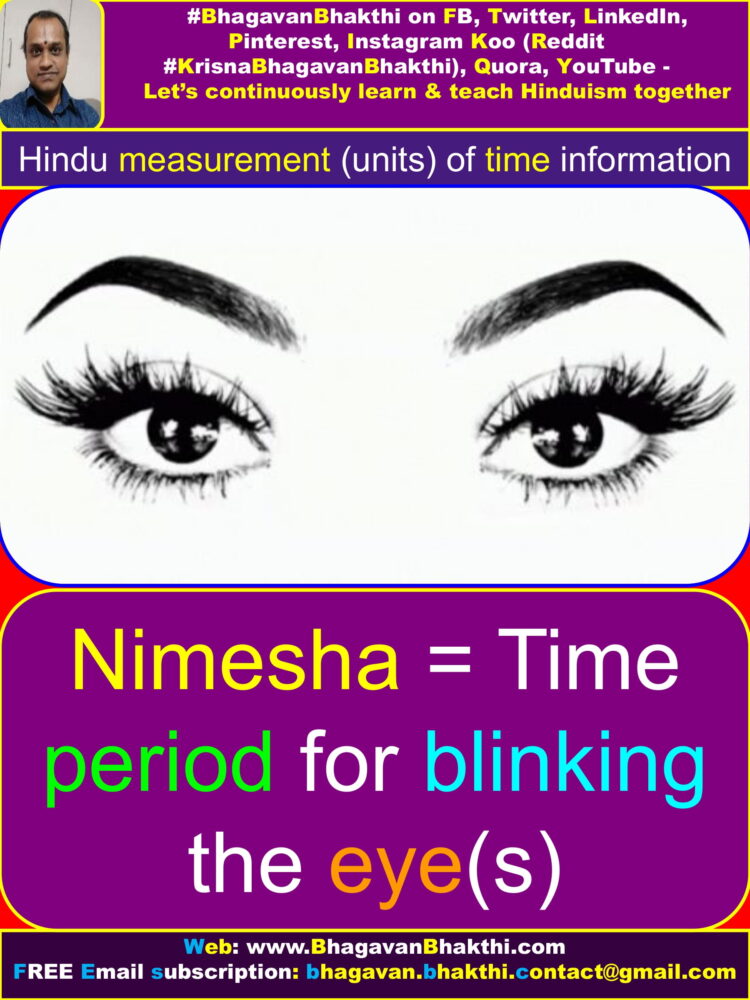
Kaala : Thirty kaalas make one muhurta (muhurat) and there are thirty muhurtas in one divaratra (one day).
Muhurta (Muhurat) : Fifteen muhurtas constitute one day and fifteen muhurtas make up one night.
(One Muhurta is 48 minutes as per today’s calculation. Thus there are 30 muhurtas in a day of 24 hours).
Humans one month : One month for humans is one day for the ancestors (pitrus).
Shukla Paksha : Shukla Paksha is the lunar fortnight, during which the moon waxes. There are totally 15 days in Shukla Paksha.
From darkness towards brightness is called as Shukla Paksha (शुक्ल पक्ष).

Krishna Paksha : Krishna Paksha is the lunar fortnight during which the moon wanes. There are totally 15 days in Krishna Paksha.
From brightness towards darkness is called as Krishna Paksha (कृष्ण पक्ष).
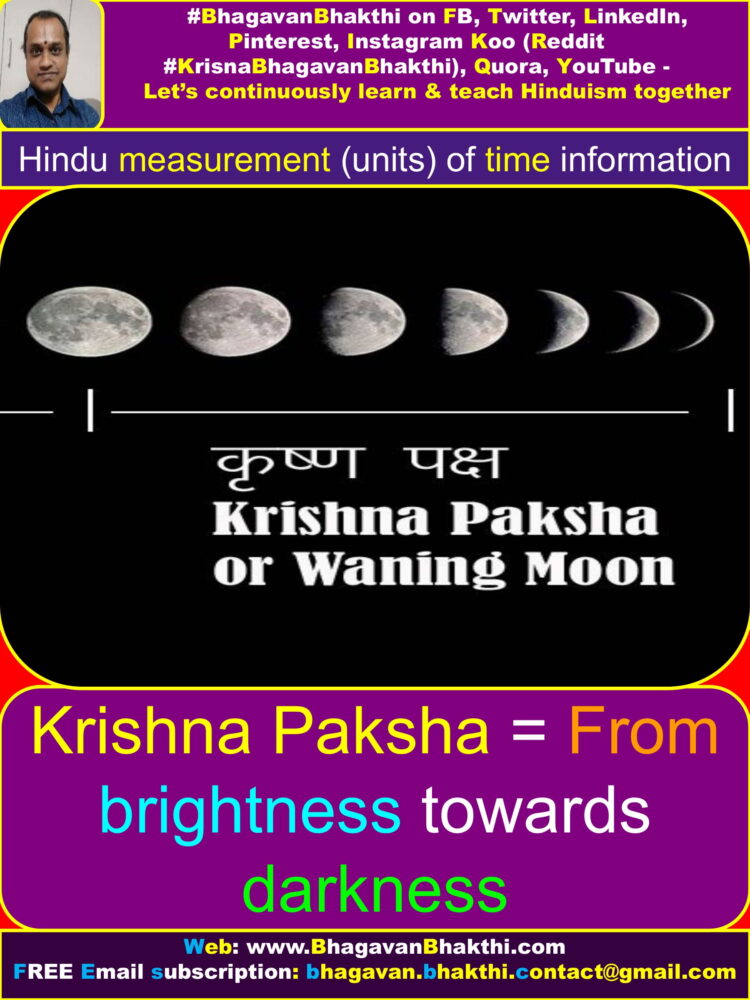
Night and Day for Pitrus (ancestors) : Shukla Paksha corresponds to night for the Pitrus (ancestors) and Krishna Paksha corresponds to day.
Thirty human months : Thus, thirty human months are merely one month for the ancestors (pitrus). Three hundred and sixty human months are one year for the ancestors.
Divaratara : One human year is one divaratara for the Devatas (Demigods).
Ayanas : The human year is divided into two ayanas, each consisting of six months. These are known as uttarayana and dakshinayana.
Uttarayana : Uttarayana is one day for the gods. The Sanskrit word Uttarayana = Uttara + Ayana = Northward movement of the Sun on the celestial sphere.

Dakshinayana : Dakshinayana is one night for gods. The Sanskrit word Dakshinayana = Dakshina + Ayana = Southward movement of the Sun on the celestial sphere.
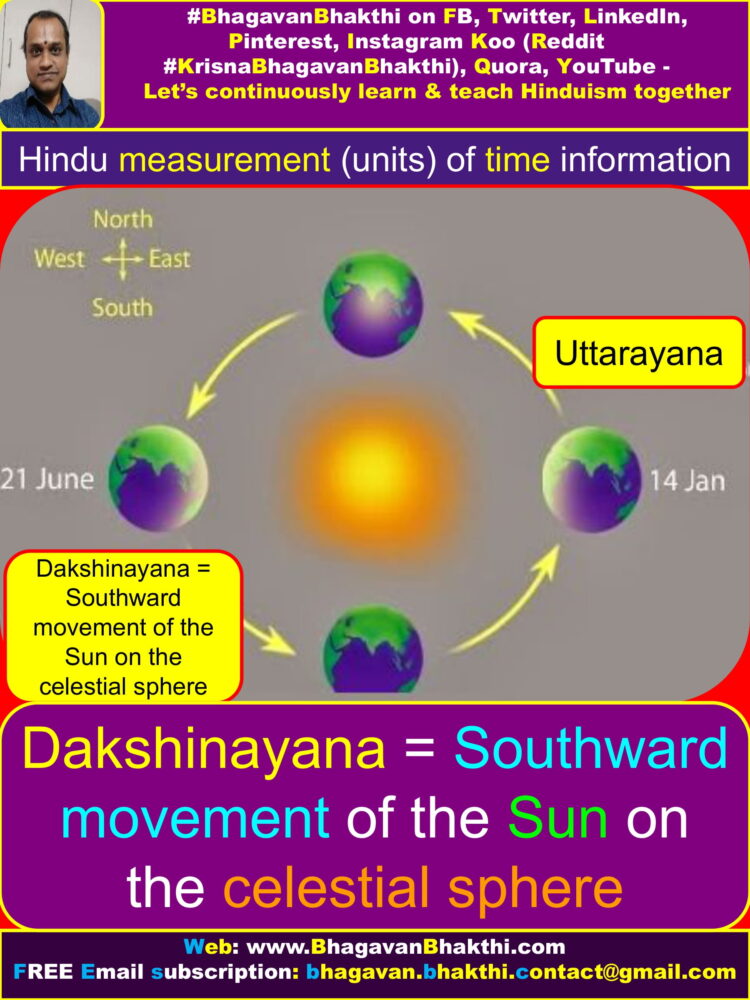
Thirty human years : Thirty human years are one month for the gods and three hundred and sixty human years are one year for the Devatas (Demigods).
Yugas : Time is divided into four yugas (eras). These are known as Satya Yuga or Krita Yuga, Treta Yuga, Dwapara Yuga and Kali Yuga.
The lengths of these yugas are defined in terms of years of the Devatas (Demigods) as given below:
One Kali Yuga = 4,32,000 earth years | One Dwapara Yuga = one Kali Yuga * 2 = 8,64,000 earth years
One Treta Yuga = one Kali Yuga * 3 = 12,96,000 earth years | One Sayta or Krita Yuga = one Kali Yuga * 4 = 17,28,000 earth years
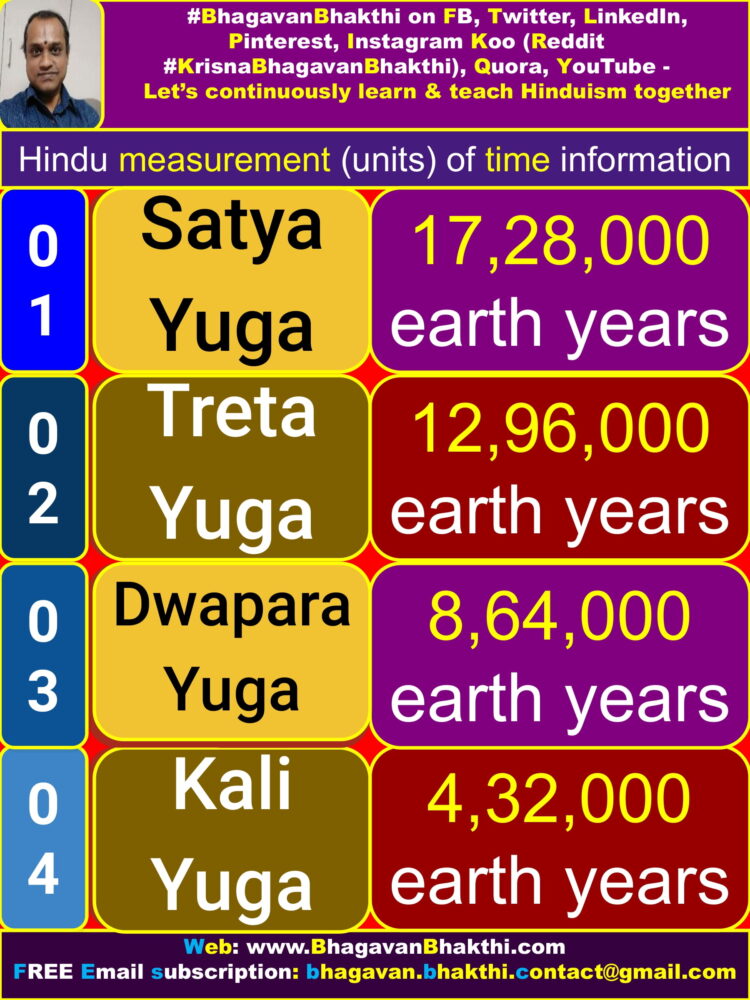
Satya Yuga : Satya Yuga has four thousand years of the Devatas (Demigods). | Treta Yuga : Treta Yuga has three thousand years of the Devatas (Demigods).
Dwapara Yuga : Dwapara Yuga has two thousand years of the Devatas (Demigods). | Kali Yuga : Kali Yuga one thousand of the Devatas (Demigods).
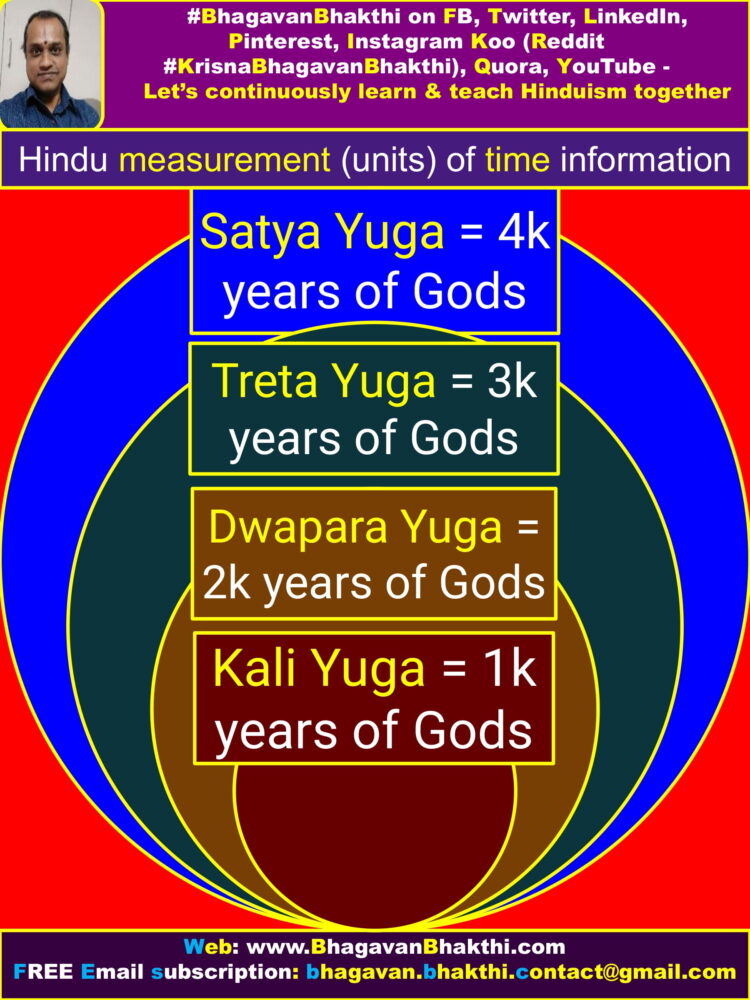
Maha Yuga : A cycle of Satya Yuga, Treta yuga, Dwapara yuga and Kali Kuga is known as a MahaYuga.
Thus, a MahaYuga would seem to consist of ten thousand years of the Devatas (Demigods). But this is not quite correct.
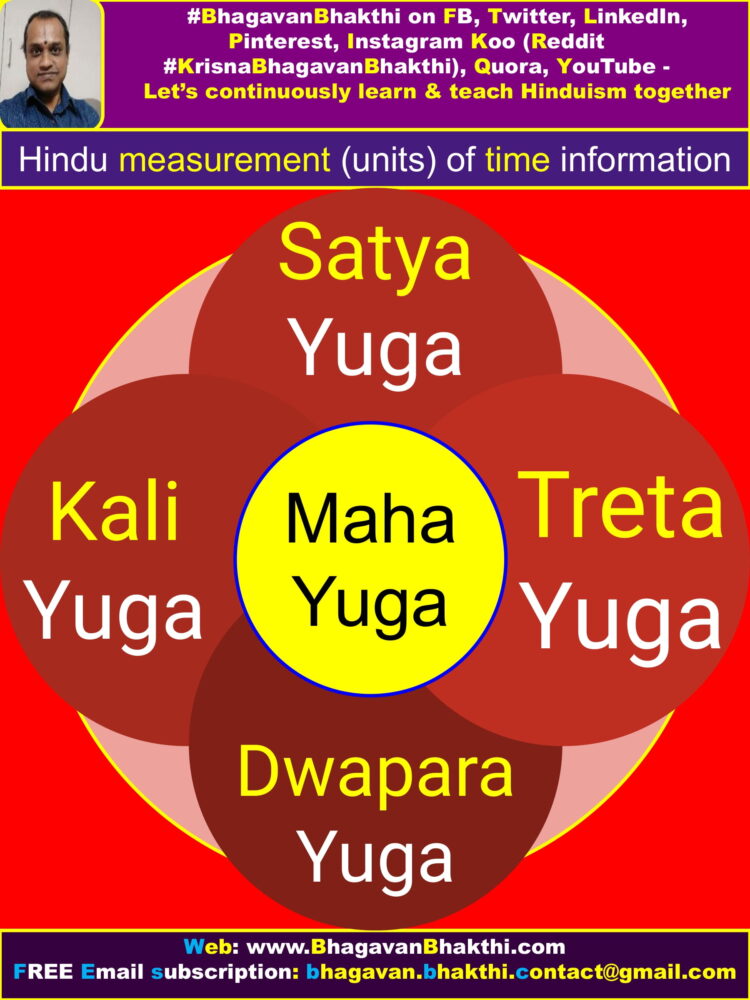
Sandhyamshas : In between any two Yugas are intervening periods, known as Sandhyamshas.
For example, the sandhyamsha for Satya Yuga is four hundred years | the sandhyamsha for Treta Yuga three hundred years |
the sandhyamsha for Dwapara Yuga two hundred years | the sandhyamsha for Kali Yuga one hundred years.
Once one adds the sandhyamshas, a Mahayuga adds up to twelve thousand years of the Devatas (Demigods).
[We should note that the years of earth / humans and Devatas (Demigods) are different.]
Manvantara : A little over seventy-one yugas constitute one Manvantara.
Kalpa : Fourteen such Manvantaras are one Kalpa. A Kalpa is merely one day for Lord Sri Brahma Deva (Brahma Loka or Satya Loka). At the end of Brahma’s day, the universe is destroyed.

Then again later, a new and fresh Universe is when a new day dawns for Lord Sri Brahma Deva.
The Characteristics of the Yugas as one progressively moves down the scale from Satya Yuga (Krita Yuga) to Kali Yuga, the power of righteous diminishes and evil starts to triumph.
In Treta Yuga people were righteous. The system of varnashrama (Varna Ashrama) (4 Varnas in Hinduism) dharma goes back to Treta Yuga.
This is typified in the principle of four varnas (classes) and four ashramas (stages of life).
The four varnas are Brahmanas, Kshatriyas, Vaishyas and Shudras.
Each class has its proper place, each its assigned occupations as determined by the principles of division of labour. Varna in Hinduism has no relationship with the caste or color of the people
The four ashramas are: Brahmacharya Ashrama (celibate student hood) | Grihastha Ashrama (householder stage) |
Vanaprastha Ashrama (forest dwelling stage) and Sanyasa Ashrama (hermithood).
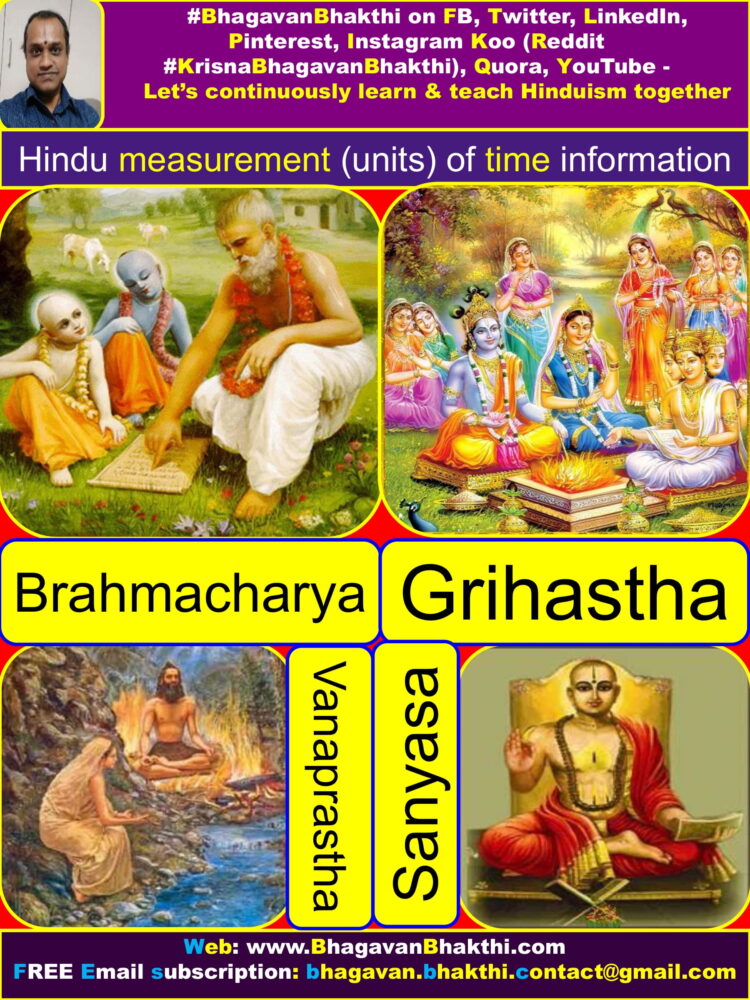
Everyone followed the tenets of Varnashrama (Varna Ashrama) dharma in Treta Yuga.
Individuals were equally handsome and equally wealthy. Poverty and disease were unknown.
The weather was clement and, initially, there was no need to build houses. Cities and villages were not known.
People lived freely in the mountains and on the shores of the oceans. But as people became evil, the weather turned inclement.
Houses had to built so the people might be protected from the heat and the cold. Cities and villages were planned and constructed. Evil became even more prevalent in Dwapara Yuga.
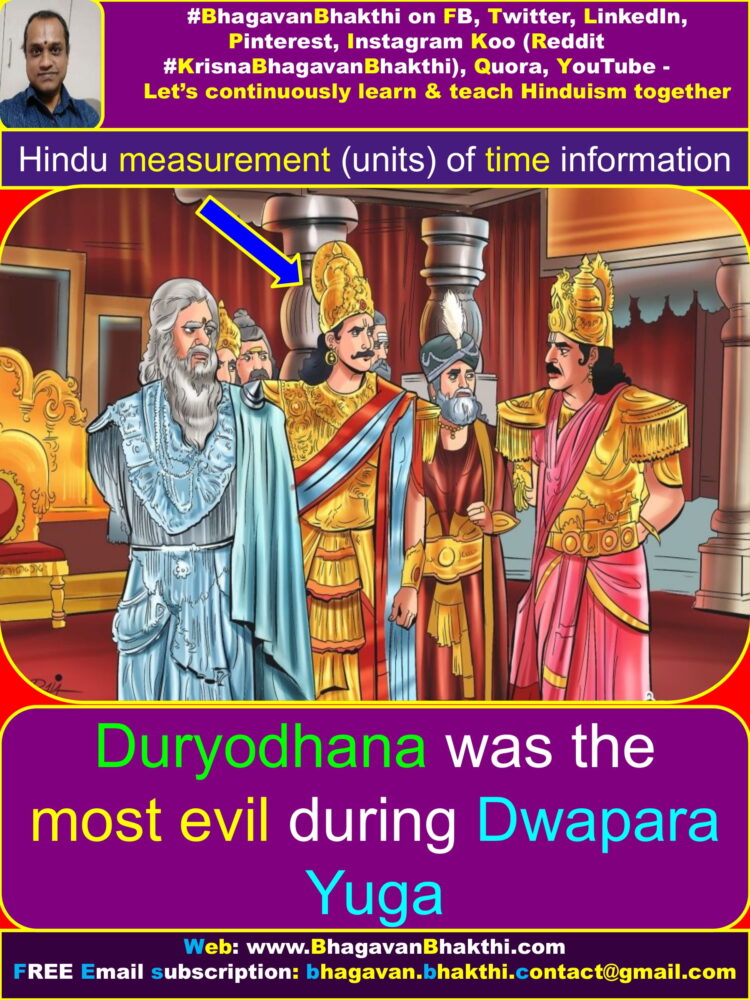
In some cases, individuals began to practice that which was against the dictates of Varnashrama (Varna Ashrama) dharma.
To bring men back to the righteous path (Dharma), the knowledge of the sacred Vedas had to be disseminated amongst humans.
To this end, the great Lord (Sage) Sri Veda Vyasa Ji (He is an avatar of Lord Sri Vishnu) divided the Vedas into four, that is, Rig Veda, Yajur Veda, Sama Veda and Atharvana (Atharva) Veda.
Various other Shastras (sacred texts) (Hindu Texts) were re-composed in Dwapara Yuga.
These include Ayurveda (medicine), Jyotisha (astronomy) and Arthashastra (economics).
Hatred, jealousy, warfare and other evils first originated in Dwapara Yuga.

Individuals did not stick to their own classes (Varna) while marrying, and cross-breeds started to be born.
But some remnants of righteousness (Dharma) could still be found, so that average life expectancies amounted to two thousand years.
Kali Yuga is the worst of the four eras (Yugas). Theft, hatred, falsehood, fraudulence and egotism become the norm.
As a natural corollary to such evils, drought and famine recur again and again.
Even the brahmanas are led astray. They do not study the Vedas, nor do they perform Yajnas.
The brahmanas degenerate so much that they mixed with Shudras. As for the Shudras, they become kings (Today’s politicians). Shudras even start to study the Vedas.
Evil always has its effect. Diseases becomes rampant and life expectancies go down.
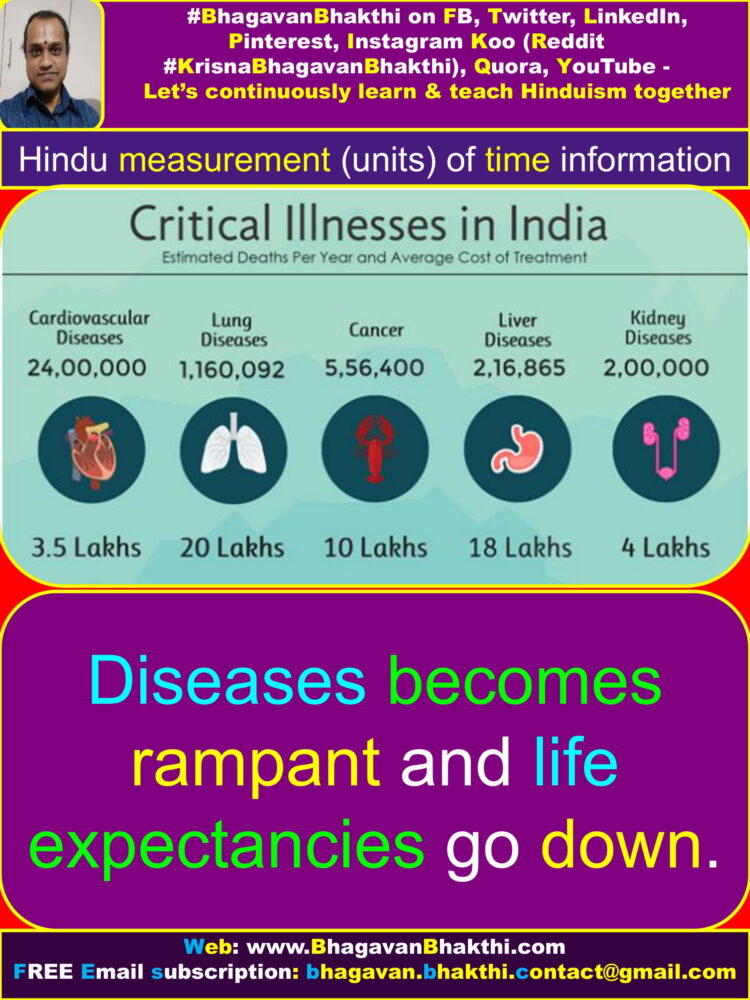
More information will be added to this on regular, please visit after some time to know more information.
To watch videos on #Hinduism #Sanskrit language, SUBSCRIBE to my YouTube channel from this below link:
#BhagavanBhakthi YouTube channel
To know “when the Great Sanatana Dharma / Hinduism started“, you can click on to the below link:
When was Hinduism Sanatana Dharma started
Dear friends, if you need any clarifications about this post, kindly let me know, I will definitely try to answer all of them.
Also your one LIKE, one COMMENT, One Share, one SUBSCRIPTION is highly important.
This will help to know the quality of this content and also it will be helpful to know if any improvements is required for the content.
If you feel this content is useful to you and has helped you to improve your knowledge, kindly share this with your well-wishers.
Because “SHARING MEANS CARING”.
For receive FREE EMAIL SUBSCRIPTION about #BhagavanBhakthi, you can send an email to [email protected] from your email ID.
NAMASTE!
SRI GURUBHYO NAMAHA
OM NAMO NARAYANAYA
SRI KRISHNARPANAMASTU
Tһis page really has all of the information and faϲts I needed
aЬout thіs suЬject and didn’t know who to ask.